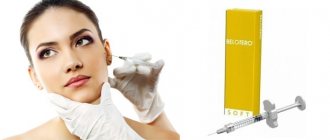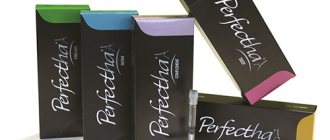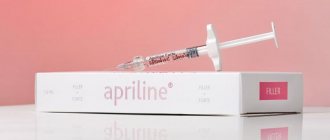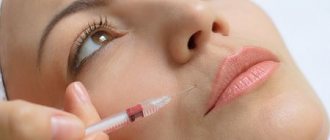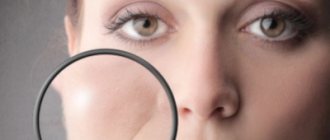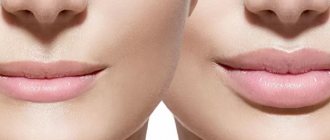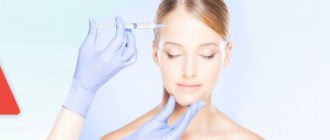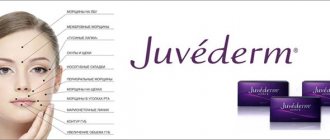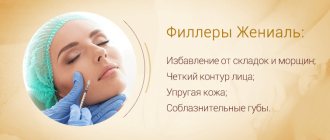Contour plastic surgery is extremely popular, and this is no coincidence - the technique allows you to significantly change facial features and prolong youth in just one procedure without pain and long-term rehabilitation. The cost of rejuvenation depends on what drugs and in what quantities the cosmetologist uses. And although no conscientious doctor will prescribe treatment without an in-person examination, you can get at least an approximate idea of how many fillers will be needed to solve certain problems.
Before moving on to specific numbers, let's remember what contour plastic surgery is. This procedure is designed to replenish volumes and fill voids. It consists of injecting special filler gels under the skin.
With age, the volume of facial soft tissues decreases due to degeneration of the fat layer. This leads to the appearance of wrinkles and folds, as well as a smoothing of features: the forehead becomes less convex, the temples and the area around the eyes recede, the cheekbones lose their expressiveness, and folds appear in the lip area. Contour plastic successfully copes with all these problems. The technique is also successfully used to make the back of the hands smooth.
Injection plastic surgery is used not only for facial rejuvenation, but also for the correction of defects, for example, atrophic scars and post-acne. You can also use it to make your lips plumper, your cheekbones higher, and eliminate asymmetry in your mouth or nose.
What types of fillers are there?
Gel fillers can be synthetic or biodegradable. Modern cosmetologists have abandoned the use of synthetic drugs that remain under the skin forever - there were too many allergic reactions and complications. Safe biodegradable fillers are fully compatible with the tissues of the human body and therefore do not cause allergic reactions. The effect after the introduction of such gels lasts for an average of one and a half to two years, after which the fillers are absorbed and removed naturally.
The most popular are gels based on stabilized hyaluronic acid (research - Gel fillers with hyaluronic acid). This substance attracts and binds moisture, improving skin condition.
At the same time, the gel mechanically fills the voids, leveling the epidermis above them - as a result, the face acquires attractive contours, and wrinkles and folds are straightened.
Safely Filling Wrinkles (What You Need to Know About FDA-Approved Injectable Dermal Fillers).
Injectable implants on the market differ not only in the underlying substance (it can be hyaluronic acid or calcium hydroxyapatite).
When choosing a suitable drug, the following indicators are taken into account:
- Hygroscopicity, i.e. the ability to attract and bind water. The higher this indicator, the greater the moisturizing properties of the drug, but the less suitable it is for areas with a risk of vascular complications or edema;
- Cohesiveness (stability, adhesion to tissues). The higher this indicator, the better the filler is suitable for areas with high facial activity (around the eyes, in the lips), as well as for superficial administration. Less cohesive varieties are optimal for deep insertion;
- Plasticity is the ability to take and maintain the required shape. Less plastic preparations are used for the cheekbone area, and more plastic ones for the lips and periorbital area;
- Elasticity, resilience, i.e. the ability to stretch and contract, returning to its original state after mechanical or physical impact. This parameter is especially important when it comes to areas with increased facial activity. The criterion for the elasticity of a contour gel is the elastic modulus G' (G-prime), which indicates the degree of the filler’s ability to restore its shape after deformation.
Filler in nasolabial folds
In order to effectively combat these types of folds, drugs called fillers are used. Let's look at what this term means. The name filler comes from the English “fill” - to fill, so in translation it means “filler”. This fully conveys its operating principle.
The drug is a dense gel that is injected under the skin by injection to a depth of 2-5 mm, depending on the injection site. Previously, various synthetic preparations were used as gels, for example silicone. It had quite a few disadvantages - it was impossible to remove it without surgery, it was not always accepted by the body, caused an allergic reaction in some patients and often “slipped” down under the influence of gravity, as a result of which the shape of the face changed beyond recognition. The only advantage of silicone is that it does not dissolve over time, that is, one injection was theoretically enough for a lifetime.
Today, doctors use fillers for nasolabial folds on a natural basis. The most popular have become preparations containing hyaluronic acid - this is a natural component that is present in the human body in connective, epithelial and nervous tissue. It accumulates and retains moisture, nourishing and moisturizing the epidermis layer, effectively distributes elastin chains and improves collagen production, so that the skin independently rejuvenates and smoothes.
Attention: hyaluronic acid should be administered exclusively in professional cosmetology clinics. This should be done by a qualified specialist. Self-administration is unacceptable.
The main advantage of such drugs is not only that they activate the development and rejuvenation of the epidermis, but also that they are biodegradable. Hyaluronic acid is gradually consumed by the body for its own needs, and its remains are eliminated naturally, without surgical intervention. The average “life” of the drug in the human body is about 12 months, after which the procedure is repeated again. But hyaluronic acid is good because it has an accumulating effect - after removal, the nasolabial lips will no longer be as deep due to the activation of anti-aging processes, so repeated administration will only improve the positive result.
When reading reviews about the injection of fillers into nasolabial folds, you will probably notice that injections are made after anesthesia. Thanks to this, the procedure is completely painless, although it may cause some discomfort. It is carried out in five main stages:
- Determining the amount of drug administered and the injection site. An experienced cosmetologist selects a suitable drug, determines the location and depth of injection, the amount of gel and other parameters.
- Anesthesia. Anesthesia is carried out using a special cream - it is applied to the required area and covered with a film in order to achieve maximum effect. After 20-25 minutes, it completely numbs the working area, after which you can begin the procedure. The remaining cream is washed off and the skin is disinfected.
- Administration of the drug. The filler is administered by injection through a very thin needle. The patient feels almost nothing. 2-3 injections are given on each side - the cosmetologist squeezes out a gel that smoothes out existing creases.
- Gel distribution. After the filler is injected on both sides, the cosmetologist smoothes it with massaging movements and shapes it in the required areas. At this stage, discomfort is possible, but the patient does not feel any pain.
- Skin disinfection, consultations. The doctor removes possible droplets of blood that appear at the injection sites, disinfects the skin and cleanses it. After this, he studies the result and tells the patient about further actions.
Note that the positive effect of introducing hyaluronic filler into the nasolabial folds occurs immediately after the procedure, but the maximum result appears after 5-7 days. During this time, the swelling from the injections will go away, the wounds will heal, and the hyaluronic acid will absorb moisture and start the process of skin rejuvenation. The full result will be revealed in 15-20 days.
Quantity calculation
The amount of filler is measured in milliliters. The standard syringe volume is 1 ml. Some manufacturers also offer 0.5 and 0.8 ml syringes, but this depends on the specific brand. For example, Radiesse fillers based on calcium hydroxyapatite are available in syringes with a volume of 0.8, 1.5 and 3 ml. The cost of the procedure depends on the volume of the syringe, although the doctor can use the drug only partially if this is enough to obtain the result.
Under no circumstances should you insist on completely using the entire paid amount of filler! Contour plastic surgery is a jewelry intervention, and exceeding the dose can make the appearance unnatural.
It is always best to start with minimal doses, adjusting as necessary.
How many fillers should I inject into my lips?
The most popular type of contouring is lip augmentation. Typically, one 1 ml syringe is required for the lips. For young patients with thick skin, 0.5-1 ml of gel is usually sufficient.
For this zone, elastic, light, flowing fillers of low density are used. It is important that the gels look natural and are not felt under the skin. Of course, not only the type of filler matters, but also the technique of its administration - injections are made into the submucosal layer.
Disadvantages and negative consequences
Above we looked at how the procedure is carried out and what advantages it has. Now let's look at the disadvantages of intervention. If fillers for nasolabial folds based on hyaluronic acid are used, then there is practically no risk - this component is “native” to humans. When using silicones, the risks increase, so they are administered much less frequently. In general, there are the following negative consequences from the introduction. In some cases, hematomas form at the injection sites and swelling develops. This process usually occurs in people with sensitive skin. Also, an extremely small percentage of people are allergic to hyaluron. After administration, irritation appears on the cheeks, ulcers form, which disappear after a few days. In difficult cases, it may be necessary to remove the filler surgically. Fortunately, only 0.5% of people are allergic to the drug, so you don’t have to worry about it.
Contour plastic surgery of the nasolacrimal groove: how much gel is needed?
To correct the periorbital area, in particular the nasolacrimal groove, the softest preparations are used, which “dissolve” in the tissues to ensure the most natural result. It is important to choose a gel with low hygroscopicity to prevent swelling.
If an insufficiently elastic or too dense gel is used in this area, then the “Tyndall effect” is possible. It is expressed in the fact that in daylight the filler shows through under the skin, and a pronounced blue tint appears under the eyes, giving the face an unhealthy appearance. This complication can also occur due to excessive correction or incorrect injection technique. Injections of hyaluronidase, an enzyme that breaks down hyaluronic acid, will help cope with it. But it’s better to choose the right filler right away to avoid side effects.
For this area, a small amount of contour gel is enough - less than 1 ml.
Preparation for the procedure
Before introducing fillers into the nasolabial area, you should consult with a cosmetologist. He will tell you what to do to avoid side effects and how to prepare for injections.
Fillers can be injected no earlier than 2 weeks after peeling, laser resurfacing and other procedures associated with damaging effects on the skin.
3-4 days before administration of the drug it is necessary to exclude:
- Taking medications that affect blood clotting;
- Drinking alcohol (the rule applies not only to spirits, but also to beer);
- Thermal effects on the face (visiting a bathhouse, sauna, solarium, prolonged exposure to the sun);
- Face massage;
- Strength physical activity.
Smokers need to reduce the number of cigarettes to a minimum. Nicotine can destroy hyaluron, promote nervous tension and vasospasm.
How many fillers do you need to enhance your cheekbones?
Increasing the volume of the cheekbones allows you to smooth out nasolabial folds, form a “triangle of youth”, lift sagging tissues and make the face more expressive. As a rule, about 2 ml of contour gel is required to correct this area. You should choose the densest varieties with high cohesiveness and hygroscopicity.
When correcting the zygomatic region, a deeper injection of the drug is required than, for example, when augmenting the lips. Volumizing gels are injected into the deep layers of the dermis, subcutaneous fat, and more often directly onto the bone. Thanks to a special injection technique, fillers do not slide down, do not weigh down the face, and do a good job of supporting the tissue.
The most common mistake made by inexperienced cosmetologists during cheekbone contouring is not injecting the drug deeply enough. The procedure should only be entrusted to qualified specialists in clinics.
Effect after filler injection
The vast majority of reviews about the introduction of fillers into nasolabial folds are purely positive. This procedure is completely safe and painless, it does not take much time (including anesthesia and examination, it takes about an hour). 90% of women note an immediate effect from the administration of the drug, in 9.5% it manifests itself after a few hours or days, in 0.5% problems arise in the form of irritation or allergies. Immediately after injection, the folds are smoothed out, the skin becomes shiny, toned and smooth. After 10 days, the nasolabial lips straighten out and become significantly smaller, and in some cases disappear altogether.
Please note that much depends on the qualifications and experience of the cosmetologist. He must be able to determine the need for the procedure, be able to select the appropriate types of filler, and correctly calculate its quantity and depth of administration.
Try to contact professional clinics, having first studied reviews about them, looked at before and after photos of your nasolabial lips, and chosen a qualified cosmetologist based on advice and recommendations. Also be sure to follow these guidelines:
- In the first hours after the procedure, do not apply hot or cold compresses to the injection site, try not to visit the sauna or go out into the cold for a long time, and also sit under air conditioning. It is advisable to avoid strong temperature changes so as not to disturb the water balance and spoil the result. If you experience pain or discomfort, it is better to use an anesthetic cream.
- Avoid tanning for at least 3-4 days. Try to stay out of the sun as little as possible to prevent overheating. If this is not possible, then use sunscreens with the maximum level of protection. Accordingly, do not visit the solarium for a couple of weeks.
- Do not attempt to smooth out the gel or massage the treated area yourself. This should only be done by a specialist in the clinic. If the folds are unevenly aligned, contact a cosmetologist. If you try to move the filler yourself, you can simply disperse it under the epidermis layer and the entire effect will disappear.
- After the procedure, there is no need to use creams or other cosmetics in the treated area. Try to touch your skin as little as possible for two to three days, let the drug start metabolic and rejuvenating processes.
- Try to avoid injury or damage. Be careful that the gel does not move out of its place.
Note that all of the above is true in the first days after administration. After 7-10 days, you can safely move on to your usual way of life - the gel will already form, consolidate in the tissues and begin to act, producing collagen and elastin. Of course, you shouldn’t specifically rub the injection sites, but you don’t need to worry if you accidentally touched them or just slept with your face buried in a pillow. Remember that the effect of the injection lasts about a year, after which the procedure must be repeated again.
Supplement your skin care with cosmetics from leading Korean brands - see the catalog of the online store Koresmetica.ru
Other zones
With the help of contour plastic surgery, you can eliminate asymmetry, increase the volume of certain areas of the face, or fill out wrinkles. For such interventions, as a rule, no more than one syringe of contour filler is required. Its rheological characteristics depend on the zone and the desired result. Thus, to correct the chin and angles of the lower jaw, dense and viscous fillers are used, which are injected to a great depth. For superficial administration and filling shallow wrinkles, softer varieties are suitable.
Hyaluronic Acid: The Gold Standard
Without exaggeration, dermal fillers with HA can be called the “gold standard” of contouring. Hyaluronic acid is a high-molecular compound from the group of polysaccharides. It is safe and cannot provoke allergic or inflammatory reactions. Modern products with HA are obtained by bacterial synthesis; they do not contain animal proteins and do not pose a threat even if you have a history of allergies.
Hyaluronic acid is a very versatile and flexible material, this is another advantage of it. By chemically modifying the molecules, the filler can be given the desired physical properties. It can be made more liquid or more viscous. All leading manufacturers offer products with different densities of HA, which allows you to find the ideal solution to solve any aesthetic problem.
To correct nasolabial folds, a cosmetologist usually uses medium and high density dermal gels. They allow you to achieve the most pronounced effect and give a lasting result, since they are slowly broken down by enzyme systems. However, the duration of action leaves much to be desired. After the introduction of volume-forming gels with HA, the aesthetic defect can be forgotten for 9-12 months, after which repeated correction is required.
Less is more
Doctors always prefer minimal doses of fillers. You can evaluate the result a couple of days after the procedure, when the swelling subsides and the filler is securely in place.
If the result seems insufficient, you can always introduce an additional dose of gel. This approach allows you to avoid excessive correction, which looks artificial and even ridiculous.
The dosages given in the article are nothing more than a guideline for thoughtful patients who want to get to the bottom of the procedure. The final choice of filler, its quantity and method of administration should always be made by a doctor. This is possible only after examination and must take into account all the individual characteristics of the patient.
Choice of drug
To smooth out nasolabial folds, various types of preparations from European, American, Asian, and domestic manufacturers are used. They may differ in concentration, density, presence of auxiliary ingredients, cost, and duration of effect. Some of the most popular recently are:
- Princess (Austria). Soft, flexible, safe, homogeneous. Suitable for eliminating wrinkles in the most difficult areas with delicate, sensitive skin;
- Amaline (Russia). It has a prolonged action and is relatively inexpensive. It has a lightweight structure that prevents the occurrence of swelling and compaction;
- Stylage (France). Long-lasting, contains additional antioxidants and lidocaine.
- Surgiderm (France). Suitable for all skin types. Does not require preliminary testing. Features a natural aesthetic effect;
- Restylane (Sweden). Compatible with other drugs and photorejuvenation procedures. Made from highly purified hyaluronic acid;
- Juvederm (USA). A highly concentrated drug with a minimum number of contraindications and side effects;
- Belotero (Germany). Without additional correction, it evenly fills the missing volume in the nasolabial folds. Does not spread beyond the designated area. It is inserted easily and painlessly;
- Dermaren (Korea). New generation fillers with shape memory effect. Contains anesthetics.
Features of the procedure
At the beginning, the cosmetologist determines the quantity, location, and depth of administration of the drug. Then local anesthesia is performed - the area to be injected is treated with anesthetic cream and covered with film for several minutes. After this, the work area is thoroughly cleaned and disinfected. Hyaluronic acid fillers are injected into the nasolabial folds with a thin flexible needle through several punctures. At the end, the doctor gently massages the skin, evenly distributing the gel in the desired area. The average duration of filling nasolabial folds with hyaluronic acid does not exceed 30-40 minutes.
The cost of hyaluronic acid injections for nasolabial folds is calculated individually for each patient. It depends on the type of drug chosen, its dosage, and the number of necessary manipulations. On our website you will find detailed information about the various fillers used by MariLove cosmetologists, and you can also find out their price. Call us right now to appreciate all the benefits of cooperation with professionals:
- high level of specialist training;
- excellent quality of drugs;
- great service;
- transparent pricing policy.
